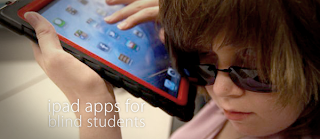Lindsey- Assistive Technologies for vision and hearing impaired children
In the video Assistive Technologies for Vision and Hearing Impaired Children , we learn facts about children in Australia who have hearing and vision impairment. This video shows many images of children using different forms of assistive technology in the classroom. From this video we learn that on average, one Australian child is identified with impaired hearing every day! One in every 2500 children have vision impairment. We see these students participating in class and activities just as everyone without disabilities would do. This is a very inspirational video that proves to us that all children can interact with one another in and out of the classroom.
The video chose was Assistive Technology Rocks My Classroom! This video is about a girl named Elina, who has a physical disability called athetoid cerebral palsy. This disability makes it hard for Elina to use her muscles for everyday activities such as: eating, walking and even talking. She started using assistive technology when she was just nine years old. Using assistive tech Elina is able to do things like: draw, paint, write in cursive and speak! She has accomplished so many things by using this technology. Elina and her classmates even taught others how to use this technology at an international conference! Elina is a perfect example of how assistive technology can help students with disabilities accomplish long term goals and overcome so many obstacles.
Amanda-The Mountbatten
The The Mountbatten, is an amazing tool that is used to type braille. This tool provides feedback to the individual as they are typing. It says each letter out loud as each button is pushed. This makes it very easy for someone who is blind to avoid making mistakes while typing. The mountbatten is a handy tool that allows files to be sent and received from a computer. It can also save files for next time when a student needs a break and wants to return to their work later. It is great for someone who is just starting to learn braille. By using this tool, students who are blind will not feel as left out during group projects in class.
The next video, Russel Hinderman using the Mountbatten, is a video I found on my own. In this video Russel is shown learning how to use the Mountbatten. He seems very eager to use the tool. This video shows that the Mountbatten can indeed be used by young students. I think this tool could be handy for anyone! The Mountbatten allows teachers to guide their students in the right direction as the tool does the talking. I think this brailler is something that is very easy to use, and can be very helpful even if students don't have a teacher sitting next to them as they type. Blind children could also use the Mountbatten for independent learning exercises.
Kayla-iPad for the Blind
In the article How The Blind Use A IPad it explains how a blind person uses the iPad. Apple has many programs an apps for the blind. Apple has a built in screen reader and this helps the blind because a screen reader reads the screen for you. For example: when you click over an app, the screen reader will read the app to you. Apple also has a Braille Display. According to this article, "a refreshable Braille display is an electronic device that displays visual information (text) as Braille (text) on a Braille display." For a blind person the Braille display can help them type and use ke
ys. The iPad and other apple products are great tools for not only the blind but for anyone.
This video iPad usage for the blind shows a blind man explaining how he uses the iPad. This video is amazing to me because not only did I just explain that a blind person can use the iPad but the video actually shows a blind person using the iPad. He seems to not have any trouble with it. I believe apple products are great for everyone. They make them easy to use for anyone.
Raven-Teaching Math to the Bind
Teaching Math to the blind
Teaching math to the blind is very difficult. Braille is the language that a blind person uses to read or write. The problem with braille is that it is very linear. Blind students are not able to how even the most simple math problems are two dimensional. When given an addition problem, a hearing student would normally line up the numbers to solve the problem. A student that is blind would see the problem on the same line.
Deaf Student Hearing Student
1234+4567 VS. 123
+4567
Art Karshmer is a professor at the University of San Francisco School of Management and Chairman of the Department of Technology. He developed a system that translates the 2-dimensional concepts of mathematical problems into a single dimensionality of braille to allow a blind student to understand those concepts into their visual cortex through touch and electronic feedback. He believes that students that are blind are barred from the study of all of the core or "stem " sciences that rely on math as their root language. His system uses small blacks with braille numbers that can be placed on a grid and can be read to the student. The block itself can also be scanned and read aloud by a computer. With this system, a braille student is able to lay out a math problem that same way a sighted student would see it on paper. Using this device with blind students can help build a foundation that will help them in their future studies.




No comments:
Post a Comment